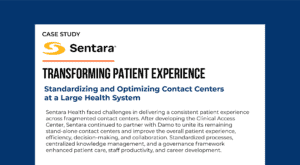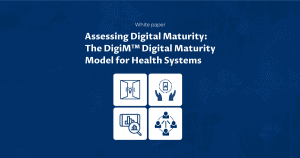Driving Digital Transformation in Healthcare: Insights from Inderpal Kohli

Healthcare is undergoing a profound shift, with technology playing an increasingly central role in improving patient outcomes, clinician efficiency, and organizational sustainability. Few leaders have been as deeply immersed in this transformation as Inderpal Kohli, a veteran healthcare executive technology leader with over two decades of experience across institutions such as Columbia University Medical Center, Hospital for Special Surgery (HSS), and Englewood Health.
In a recent episode of The Big Unlock podcast, Inderpal shared his journey, lessons learned, and his perspectives on the future of healthcare digital transformation. His experiences shed light on how health systems can approach innovation thoughtfully, balance risks with rewards, and deliver tangible results for both patients and clinicians.
Listen to the full conversation
A Career that Blends Technology with Care
Like many technologists who entered healthcare by chance, Inderpal’s career began in software development for the banking and financial industry. A project assignment at Columbia University Medical Center introduced him to biomedical informatics and clinical research systems—a turning point that solidified his decision to stay in healthcare.
At Columbia, he witnessed firsthand how research innovations could translate from “bench to bedside.” That early experience taught him the importance of building digital solutions that directly impact patient care. His subsequent roles at HSS and Englewood Health gave him opportunities to work on digital transformation initiatives at scale—from EHR implementation and clinical system integration to enterprise-wide modernization in cybersecurity, networking, and data centers.
This journey highlights a central theme in healthcare IT leadership: success comes not just from technical expertise, but from understanding the continuum of patient care and clinician needs.
Digital Pathology: A Breakthrough in Diagnostics
One of the projects Inderpal is most proud of is the digital pathology transformation at HSS. While radiology has long been digitized, pathology remained tied to glass slides and microscopes. Recognizing the inefficiencies of this approach, he championed a program to digitize pathology workflows, working with Epic, PACS vendors, and scanner providers.
The timing coincided with the COVID-19 pandemic, which accelerated adoption. Within a year, 70% of pathology cases were being diagnosed digitally—a remarkable achievement for a specialty deeply rooted in traditional methods.
The benefits went beyond efficiency. Digital pathology allowed pathologists, surgeons, radiologists, and infectious disease specialists to correlate images seamlessly, improving collaboration and patient care. It also opened the door to AI-powered tools for cell counting, pattern recognition, and diagnostic quality improvement.
As Inderpal noted, digital pathology was “a first in the country” at that time and set the stage for broader adoption of AI in diagnostics.
Patient Engagement and Remote Care Yield Measurable Outcomes
At Englewood Health, Inderpal spearheaded a three-pronged digital physician strategy:
- Patient engagement and self-service: By expanding digital front doors and enabling online scheduling, Englewood achieved an 18–20% increase in digital appointments, despite the cultural challenge of convincing physicians to open their schedules.
- Proactive outreach through digital campaigns: Using Epic’s CRM platform, Englewood launched automated campaigns for preventive care screenings like mammograms and colonoscopies. The results were significant—21% success in first-time mammogram screenings and 6% success in new preventive screenings, far outperforming traditional paper-based outreach.
- Remote patient monitoring (RPM): Starting with blood pressure monitoring, the program showed early success, with 84% of participating patients demonstrating improved outcomes within six months.
These initiatives reinforced a powerful lesson: when thoughtfully integrated with core systems like Epic, digital engagement strategies not only enhance convenience but also deliver measurable improvements in population health.
Supporting Clinicians Through Ambient Technology and AI
A recurring theme in Inderpal’s work is reducing the burden on clinicians. At Englewood, he introduced ambient documentation technology to relieve physicians of the after-hours “pajama time” spent completing charts.
The impact was significant:
- 40% reduction in after-hours documentation among physicians using ambient solutions.
- Improved patient satisfaction, as doctors could focus more on conversations rather than typing notes.
- Potential financial benefits from more accurate coding, with some organizations reporting savings of up to $13,000 per physician per year through improved HCC and E&M coding.
In addition, AI-driven tools are now assisting with MyChart message responses, chart summarization, and prior authorization workflows. By embedding these technologies within the EHR, organizations can scale efficiencies while maintaining clinician trust.
Overcoming the Challenges of Digital Transformation
Despite the successes, Inderpal is candid about the challenges. He categorizes them into technology, process, and resource barriers:
- Technology: Beyond obsolete systems, technical debt often shows up in how solutions were originally designed without a digital-first mindset. Fixing foundational data definitions and architectures is critical for making data-driven decisions.
- Process: Healthcare organizations must embrace agile experimentation rather than expecting every project to succeed. Piloting solutions for 90 days, measuring KPIs, and being willing to walk away is essential—yet culturally difficult for organizations used to long project cycles.
- Resources: IT teams trained in controlled clinical environments must adapt to the unpredictable world of patient-facing solutions, where user experience (UX) plays a critical role. Many organizations are now building dedicated digital teams with consumer-oriented skills to bridge this gap.
These insights emphasize that digital transformation is as much about mindset change as it is about technology adoption.
The Future: AI, Agentic Workflows, and Personalized Medicine
Looking ahead, Inderpal sees AI and agent-based automation as central to the next phase of transformation. While today’s deployments focus on low-risk, non-clinical areas such as scheduling and payments, he predicts rapid expansion into clinical workflows.
- Ambient AI will become pervasive across inpatient and outpatient care, evolving beyond physician documentation to nursing and other clinical roles.
- Agent AI will transform back-office functions like prior authorization, denials management, and patient communication, streamlining administrative burdens.
- Digital twins—though currently cost-prohibitive—hold promise as a game-changer, enabling organizations to simulate and test changes before real-world rollout.
- Ultimately, the pinnacle of AI in healthcare will be personalized medicine, where treatments and dosages are tailored to individual patients rather than populations.
Inderpal captures the spirit of this transformation with a memorable quote:
“AI won’t replace clinicians, but clinicians who use AI will outperform those who don’t.”
The message is clear: healthcare’s future will be shaped not just by tools, but by how leaders and clinicians reimagine workflows, patient interactions, and care delivery through these tools.
A Pediatric-Centric Approach to AI
Pediatric healthcare comes with its own unique challenges—fewer available data points, smaller population sizes, and higher sensitivities around communication and consent. This makes the responsible use of AI even more critical.
Dr. Morse noted that solutions must be designed with children and families in mind, not simply adapted from adult care settings. Whether deploying ambient tools, summarizing clinical notes, or streamlining administrative workflows, every use case must prioritize trust, safety, and patient experience.





